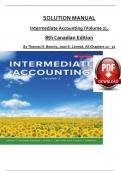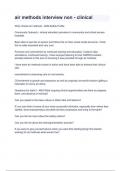SOLUTION MANUAL
Intermediate Accounting (Volume 2),
8th Canadian Edition
By Thomas H. Beechy, Joan E. Conrod, All Chapters 12 - 22
,TABLE OF CONTENTS
VOLUME 2
Chapter 12: Financial Liabilities and Provisions
Chapter 13: Financial Instruments: Long-Term Debt
Chapter 14: Shareholders' Equity
Chapter 15: Financial Instruments: Complex Debt and Equity
Chapter 16: Corporate Income Tax
Chapter 17: Tax Losses
Chapter 18: Leases
Chapter 19: Post-Employment Benefits
Chapter 20: Earnings per Share
Chapter 21: Accounting Changes
Chapter 22: Financial Statement Analysis
,Chapter 12: Financial Liabilities and Provisions
Case 12-1 Winter Fun Incorporated
12-2 Prescriptions Depot Limited
12-3 Camani Corporation
Suggested Time
Technical Review
TR12-1 Financial liabilities and provisions (IFRS) ...... 10
TR12-2 Financial liabilities and provisions (ASPE) ..... 10
TR12-3 Provision, measurement ................................... 10
TR12-4 Guarantee ......................................................... 10
TR12-5 Provision, warranty .......................................... 5
TR12-6 Foreign currency .............................................. 5
TR12-7 Note payable .................................................... 5
TR12-8 Discounting, note payable................................ 10
TR12-9 Discounting, provision ..................................... 10
TR12-10 Classification, liabilities................................... 10
Assignment A12-1 Financial versus non-financial liabilities……. 10
A12-2 Common financial liabilities………………… 10
A12-3 Common financial liabilities............................ 10
A12-4 Common financial liabilities: taxes ................. 20
A12-5 Common financial liabilities: taxes ................ 20
A12-6 Foreign currency payables……………………. 10
A12-7 Foreign currency payables ............................... 10
A12-8 Common financial liabilities and foreign currency 25
A12-9 Provisions......................................................... 20
A12-10 Provisions ........................................................ 20
A12-11 Provisions......................................................... 20
A12-12 Provision measurement .................................... 15
A12-13 Provision measurement .................................... 15
A12-14 Provisions; compensated absences…………... 15
A12-15 Provisions; compensated absences .................. 15
A12-16 Provisions; warranty ........................................ 15
A12-17 Provisions; warranty ....................................... 20
A12-18 Provisions; warranty ....................................... 25
A12-19 Discounting; no-interest note ........................... 15
A12-20 Discounting; low-interest note ........................ 20
, A12-21 Discounting; low-interest note 20
.........................
A12-22 Discounting; provision..................................... 15
A12-23 Discounting; provision..................................... 25
A12-24 Discounting; provision..................................... 25
A12-25 Classification and SCF..................................... 20
A12-26 SCF 20
..................................................................
A12-27 Liabilities – IFRS and ASPE .......................... 10
A12-28 Liabilities - ASPE ........................................... 20
A12-29 Liabilities - ASPE ............................................ 20
A12-30 Provisions/Contingencies – IFRS and ASPE…. 20
A12-31 DAIS – warranty provision trend……………... 15
A12-32 DAIS – provision for coupon refund………… 15
Cases
Case 12-1 (LO12.3, LO12.5, LO12.6)
Winter Fun Incorporated
To: Members of Board of Directors
From: Accounting Consultant
RE: Winter Fun Incorporated
Overview
Winter Fun Incorporated (WFI) uses IFRS for financial reporting. The bank loan has a
minimum current ratio so you will need to be careful and watch for any impacts on the
ratio. You have had a tough year this year and faced a loss so the bank financing is
criticalto your operations.
Issues
1. Revenue recognition memberships
2. Revenue recognition guests
3. Special promotions
4. Coupons
5. Manufacturer Loan
6. Lawsuit
7. Warranty
8. Gasoline storage tanks
9. Foreign currency payables
10. Compensated absences
,Analysis and Recommendations
1. Revenue recognition
membershipsFollowing the 5 step
IFRS model:
Initiation fee
Step 1: The contract with the customer is for the membership in the club. This would be
awritten agreement between the member and WFI.
Step 2: There is one performance obligation, the promised service is membership in the
ski club. There is no transfer of the service until the membership is provided.
Step 3: The contract price is $10,000. The non-refundable deposit is an advance
payment towards this initiation fee and is part of the overall transaction price.
Step 4: No allocation since there is only one performance obligation.
Step 5: The performance obligation for the initiation fee is satisfied over the period of
time that the member belongs to the club. The $10,000 would be recognized over the
average period a member belongs. There should be enough historical data available to
come up with a reasonable estimate. There would be no cash collection risk since the
amount is paid upfront.
Annual fee
Step 1: The annual fee is a written agreement between the member and
WFI.Step 2: There is again one performance obligation, the service for this
year.
Step 3: The fee of $2,000 is the total contract price and is received in 20X5 for the
20X6ski season. This would be unearned revenue when received.
Step 4: There is no allocation since there is only one performance obligation.
Step 5: Assuming the ski season goes from Dec 1 until March 31 $500 would be
recognized in 20X5 and the remainder in 20X6 which would be the period in which the
service is performed. There would be no cash collection risk since the amount is paid
upfront.
2. Revenue recognition guests
,Following the 5 step IFRS model:
Step 1: The contract with the guest is the written contract when they receive the ticket
toski, not when the reservation is made since this reservation could be cancelled.
,Step 2: The performance obligation is the right to ski that
day.Step 3: The overall contract price is the price of the ski
ticket.
Step 4: There is no allocation since there is only one performance obligation.
Step 5: The performance would be the right to ski on that day. There is no cash
collectionrisk since the guest pays by credit card when they purchase the ticket.
3. Special promotions
Following the 5 step IFRS model:
Step 1: The contract with the customer is the written contract when they receive the
ticketand the right to a future lesson.
Step 2: There are two separate performance obligations the right to ski and the right to
thelesson.
Step 3: The total contract price is $100.
Step 4: This price would need to be allocated to the two separate performance
obligationsbased on their relative fair value.
Fair value ski pass 80 = 61.5% x 100 = $61.50 Fair
value lesson 50 = 38.5% x 100 = $38.50 Total fair
value 130
Step 5: The $61.50 allocated to the performance obligation for the ski pass would be
satisfied on the day that they ski. For the $38.50, the performance obligation would be
satisfied on the day they take the lesson. There would be no cash collection risk
assuminga credit card is used to purchase the special pass.
4. Coupons
It must be determined if an economic loss would occur for the coupons. The coupons
are for $5 and the price of a ski pass is $80. This is a minor amount compared to the
price of the ski pass so WFI would still be selling the ski pass at a profit. Therefore, the
coupons should only be recognized as a cost when they are redeemed.
5. Manufacturer Loan
,The manufacturer of the ski lift has provided a 0% interest loan. This is often referred to
as a dealer loan. The loan is either measured in FVTPL or other liabilities. Most liabilities
, are measured in other liabilities and since there is no mismatch I recommend this loan
be recorded in other liabilities and not to elect FVPL. WFI is required to record the loan
at fair value using the market rate of interest which would be their incremental
borrowing rate of 8%. Therefore, the loan would be recorded at $2.5 million (2
periods, 8%) =
$2,143,350. The loan would then be amortized using the effective interest method and
interest expense of $171,468 would be recorded in 20X5. This would not impact the
current ratio in 20X5 because the full amount would be presented as long term.
6. Lawsuit
It must be determined if the lawsuit is probable and if the amount can be measured.
The Board has decided to settle the lawsuit therefore it is probable there will be a
payment. The amount will be based on management‘s best estimate. Since there is a
range, this would be the midpoint of the range or $250,000 should be accrued as a
provision, assuming each point is equally likely. In addition, there would be note
disclosure on the details of the lawsuit. This liability would be current if the payment is
expected to be made next year, which would have a negative impact on the current
ratio.
7. Warranty
The warranty is not a separate performance obligation – it is an assurance warranty
(also known as a standard warranty). In the period in which the skis are sold, a warranty
provision should be set up for the estimated costs to be incurred to service the skis as
long as the warranty costs are considered probable. If historically costs are low, the
provision may be small.
The provision is set up with a debit to warranty expense and credit to the provision for
warranty. Subsequently, when costs are incurred, the warranty provision is debited, and
cash, parts or other materials is credited.
Since the warranty provides a lifetime guarantee, at least a portion would likely be a
non- current liability. The portion that is expected to relate to the following year, would
be reported as a current liability at the reporting date. Any current portion would affect
the current ratio negatively.
8. Gasoline storage tanks
The gasoline storage tanks would be set up as an item of property, plant and equipment
and depreciated over the 15 years. The costs to remove the tanks would be a legal
obligation and would need to be set up as a decommissioning provision. The provision





